Class 6 English Chapter 3 Question Answer Guide - NCERT Solutions for Nurturing Nature
NCERT Solutions for Class 6 English Poorvi Unit 3 include the following chapters:
 Table of Content
Table of ContentNeem Baba,
What A Bird Thought
Spices that Heal Us.
These 3 chapters of the Class 6 English Syllabus showcase the beauty of our nature though plant and animal life and even go beyond by portraying the different benefits and medicines that we obtain from the nature around us.
The NCERT Solutions for Class 6 English for Chapter 3 of the English Poorvi textbook by Vedantu provides solutions to all textbook questions straight from the minds of top master teachers and subject matter experts straight to you and are available in FREE PDF format for easy availability and to help you study anywhere, anytime as you wish. Download the FREE PDF for NCERT Solutions for Class 6 English Chapter 3 today and crack your exams with the utmost confidence!
Glance on Class 6 English (Poorvi) Chapter 3 Nurturing Nature
Unit 3 of the Class 6 English Poorvi textbook consists of one chapter, one poem and one excerpt:
Neem Baba:
Amber talks to a neem tree, which introduces itself as Neem Baba and shares its ancient origins in India.
Neem Baba explains its widespread presence in various countries and the different names given to it, including ‘magic tree’ and ‘bitter grace of God.’
The neem tree is used for medicinal purposes, including treating measles and making natural remedies for various ailments.
Neem Baba also helps farmers protect crops from pests, purifies the air, and offers several other uses in daily life, like making toothpaste and furniture.
What a Bird Thought:
The bird first lives in a small house and believes the world is round and small, like a pale blue shell.
In its nest, the bird thinks the world is made of straw and is cozy, surrounded by its mother.
As the bird leaves the nest, it realizes the world is larger and made of leaves, expanding its perspective.
Upon flying beyond the tree, the bird acknowledges that it doesn’t fully understand how the world is made, nor do others.
Spices that heal us:
Daadi shares natural remedies using kitchen spices, which she learned from her grandmother.
She explains the medicinal benefits of common spices like haldi, methi, jeera, and ginger for digestion, pain relief, and cold treatments.
Daadi encourages Vikram and Vaibhavi to remember these cures and share them with friends.
The letter highlights the importance of passing on traditional knowledge about healing properties of spices across generations.
Class 6 English Chapter 3 Question Answer Guide
Neem Baba:
Let us Do these Activities Before We Read. (Page 75)
1. A tree is useful to us in many ways. Mention some of these uses. Write them in the picture given below.

Answer:
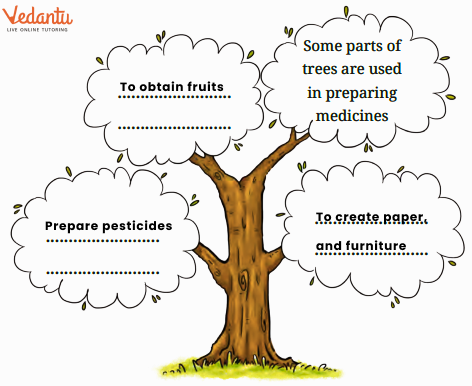
2. Neem is a common tree in our country. Discuss in groups of four and fill Columns A and B with what you know about the neem tree and what you want to know.

Answer:
Column A | Column B |
Indian tree | Height |
Bitter Taste | How Large is it |
Medicinal properties | Why does it not yield vegetables and fruit |
Strong bark | Other Agriculture uses |
Let us Discuss:
Amber found many facts about the neem tree from Neem Baba. Fill up the fact sheet based on what Neem Baba told her.

Answer:
Let us Know Our Neem | ||
Common Name: | Neem | Given by: Iranians |
Period of birth | Million Years Ago | |
Born at: | Mynammar | |
Found in: | Asian, African Countries, and Parts of America | |
Common Names: | Nimba, Nimbaca, Nimb, Nim, Leemba, Nimori, Nimo, Nimbe, Nimbamond | |
Names given by scientists | 1. ‘Bitter grace of God’ | 2. ‘Nature’s gift to man, ‘Cleanliness Parting tree’ |
Names given by others | 1. Magic tree | 2. The tree of the twentieth century |
Question 1. How is neem useful to farmers?
Answer: Farmers find neem beneficial, as neem seeds are ground into powder, mixed with water, and sprayed on crops to repel termites, locusts, and insects. Additionally, it helps prevent mosquitoes from breeding.
Question 2. Mention some of the uses of the neem tree.
Answer: Furniture made from neem wood is resistant to termites. Neem leaves help protect stored grains and clothes. The tree purifies the air, and its twigs are used for cleaning teeth. Every part of the neem tree is utilized in making medicines, and the leaves also safeguard grains in storage.
Let us Think and Reflect (Page 81)
Question 1. You just read about the Neem tree. Write any two facts that surprised you the most.
Answer: Every part of the neem tree holds medicinal properties, and furniture crafted from neem wood is immune to termite attacks.
Question 2. Complete the following sentences.
(a) The old man asked Amber to call him Neem Baba because ______________________.
Answer: the neem tree was very old.
(b) Neem seed powder protects crops from ______________________.
Answer: Termites, insects and mosquitoes.
(c) ______________________ is a cost-effective method to stop mosquitoes from breeding in stagnant water.
Answer: Powdered Neem seeds mixed with water
(d) One reason why doctors advise us to use neem leaves for someone suffering from measles is _____________________.
Answer: To kill germs and stop it from breeding, thus causing irritation and infection.
Question 3. Why can Neem Baba not remember the year when he was born?
Answer: Millions of years have passed since Neem Baba was born, which is a significantly long time, thus, he cannot remember the year he was born.
Question 4. Which parts of the neem tree are used to make medicines?
Answer: Almost all the parts of the neem tree, such as roots, bark, and leaves are used to make medicines.
Let us Learn (Page 81)
Question 1. Study these words from the text.
something
neem oil
cleanliness-parting
well known
grandmother
seed powder
childhood
well trained
thought-provoking
Put the compound words given above in their trees. These words are known as compound words. There are three types of compound words, based on how the words are separated.
Open compound words: spaces between the words.
Closed compound words: no spaces between the words.
Hyphenated compound words: hyphens between the words.
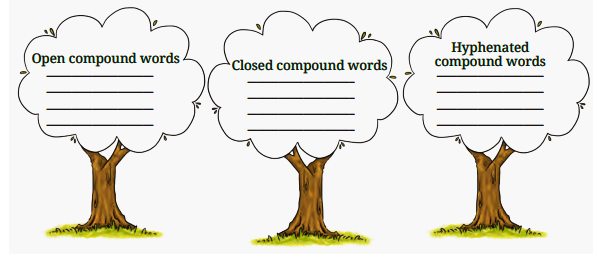
Answer:
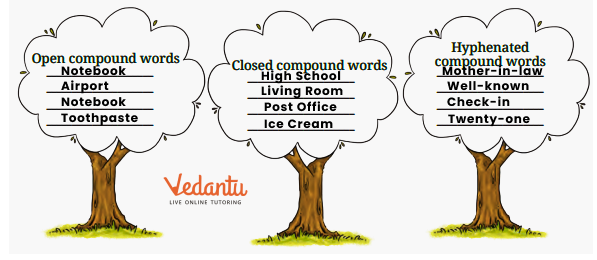
2. Words that tell us what a person is doing are called verbs. In the table given below, match the verbs in the first column showing action in the present to verbs in the second column showing action in the past. Make a sentence with any one form of the verb. One has been done for you.

Answer:
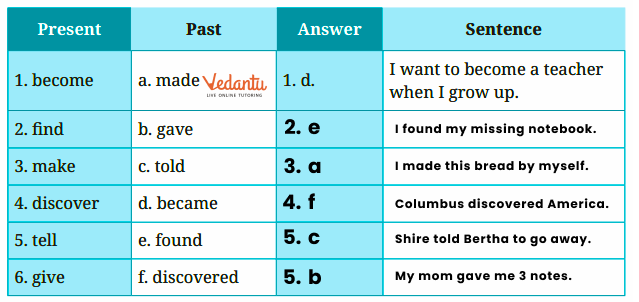
Let us Explore (Page 84)
When people from Persia came to India and saw that a common tree of their country was freely growing here, they started calling the tree Azad Darakhte Hindi. So, the scientific name of Neem in Latin became Azadirachta indica.
Neem has different names in the Indian languages. Discuss with your teacher and find out which Indian languages these names belong to.

Answer:

What the bird thought
Let us Do These Activities Before We Read. (Page 85)
Question 1. Look at the picture and discuss what you see in the picture with your teacher and classmates.

Think of a time when you worked hard. What did you do then?
How did it help you?
How did it make you feel?
Also, discuss in groups.
2. Where are the places you see birds?
What do you see the birds doing?
Answer: Birds can be spotted in gardens, parks, trees, and buildings, often flying and moving from one location to another. They gather food such as grains and worms to eat.
3. Do you want to fly like a bird? Why?
Answer: I wish to fly like a bird to freely explore the world.
4. What does a baby bird think about its world?
Answer: At first, she believed her world was the blue shell, then discovered it was her nest. After leaving, she flew into the vast, expansive world.
5. Read the sentences and replace the underlined words with their correct meanings.
S.No. | Sentences | Meanings |
(a) | The color of the feather was not dark but pale. | at last |
(b) | The butterfly moved lightly and quickly onto the flower. | light |
(c) | Finally, I finished my bird painting after trying it many times. | labor |
(d) | The pretty flowers were the prize for the gardener’s hard work. | fluttered |
Answer:
Pale - Light
Moved lightly and quickly - Fluttered
Finally - at last
Hard work - labour
Let us Discuss
1. Read the poem again. Identify the main idea of each stanza. There are two extra given.
(a) The bird steps out into the world.
(b) The bird lived happily in a small world.
(c) The bird becomes blind due to leaves.
(d)The bird flies away as an adult.
(e) The bird is unhappy with the straw nest.
(f) The bird lived in a cosy nest with its mother.
Answer:
(a) The bird becomes energetic as she grows and flies to discover things for herself.
(b) The bird lives happily and secures in her nest.
(c) The bird flies out of the nest and sits on another branch and can see only leaves and feels blinded by the leaves around her.
(d) As an adult she flies into the wide world.
(e) bird is unhappy.
(f) The bird is comfortable with her mother.
Question 2. Look at the pictures (a) – (d) and write the matching line from the poem for each.

Answer:
Round nest in a shell
Nestled by mother
Blind by leaves
Steps out into the world
3. Answer the following with a word from the poem and check the answers with your partner.
(a)What was the shape of the bird’s first house? _ O _ _ _
(b) What was the bird’s second nest made of? _ _ R _ _
(c) What did the bird see when it came out of its nest? L _ _ _ E _
(d) What did the bird do at the end? _ _ _ W
Answer:
ROUND
STRAW
LEAVES
FLEW
Let us Think and Reflect
1. Write whether the following sentences are True or False.
(a) The bird changed its house two times.
(b) The neighbours tell the bird about the world
Answer:
True
False
2. Read the following lines from the poem and answer the questions
given below.
(a) I thought the world was made of straw,
And nestled by my mother.
(i) Who lived in the nest along with the baby bird?
Answer: The baby bird’s mother.
(ii) Complete the following by choosing the correct option.
The bird thought the world was made of straw because
__________.
a. it lived in a straw hut
b. its nest was made of straw
c. its mother fed straw to it
d. there was straw all around
Answer: It’s nest was made of straw
(iii) Which word tells us that the baby bird was warm and
comfortable?
Answer: Nestled by the mother
(b) I said the world is made of leaves,
I have been very blind.
(i) Why did the bird think the world was made of leaves?
Answer: The bird thought that the world was made of leaves because she saw leaves all around her as she moved into the nest which was on a tree branch.
(ii) What does the set of words ‘I said’ mean?
(a) flew
(b) shouted
(c) spoke
(d) cried
Answer: (c) spoke
(iii) Fill in the blanks to complete the sentence. The bird felt that it had been very blind because it could not __ __ __ the leaves from __ n __ __ __ e the nest
Answer: See, Inside
3. Why did the baby bird think that its first world was small, round and blue?
Answer: The baby bird was in a shell which was small, blue and round before moving to the nest. This is why the baby bird first thought that the world was small, round and blue.
4. Where did the bird go when it fluttered from its straw nest?
Answer: It flew into the world to explore and learn about it on its own.
5. What quality did the bird say it had, when it flew away?
Answer: The bird had matured and was full of the energy of an adult when it took flight.
6. Who do you think were the bird’s neighbours? Why do you think so? Discuss.
Answer: All the surrounding creatures were her neighbors, and since the bird had to live among them, they became her permanent companions.
Let us Learn
1. Let us write some rhyming words. One has been done for you

Answer:

Now, complete a new stanza with rhyming words at the end of each line.
I fly high and I fly low,
But one thing I surely k __ __ __,
Whenever I wish to rest,
My little nest is the __ __ __t.
Answer: Know, Best
2. The poet uses words like ‘pale’, ‘blue’, ‘round’, ‘straw’ and ‘little’ to describe the bird’s nest. Read a few more describing words. pointed green thin brown small wooden hanging round.

Now, use the describing words given in the box to create six sentences
based on the given picture.

(a) ……………………………………
(b) ……………………………………
(c) ……………………………………
(d) ……………………………………
(e) ……………………………………
(f) ……………………………………
Answer:
The bird has a pointed beak.
The leaves of the tree are green on which the bird built her nest.
The nest is hanging from a thin branch.
The colour of the nest is brown.
The nest is small but cozy.
The entrance to the nest is round in shape.
Let us Write
1. Read how the bird perceived its world.
My world was small, round and light blue at first. After that my world was warm and comfortable. It was made of straw. In this world I could only see leaves whenever I stepped out. In the end, my world became big. It had the sky and the earth as a part of it.
2. Now, discuss with your teacher and classmates how you think the world
would look to the following.
a baby
a fish
3.Now, write five sentences each, for both (a) and (b), in your notebooks. You can take help from the example given in 1.
A baby:
My world is soft and calm, with the gentle touch of my parents and the warmth of their arms around me.
I see bright, smiling faces, and their voices make me feel safe and happy.
My world is filled with soothing music, colorful mobiles, and the soft glow of night lights.
As I grow, I start to notice new shapes, colors, and sounds, sparking my curiosity about everything around me.
Soon, my world will expand to places like the garden, where I’ll feel grass under my feet and watch butterflies fluttering by.
A fish:
My world is cool and quiet, filled with the gentle flow of water around me.
I swim through bright coral and plants, surrounded by colorful fish who dart in and out of view.
The bubbles and ripples above make me curious about what lies beyond the water’s surface.
My world is full of tiny creatures I can chase and streams of light that dance through the water.
One day, I might explore deeper waters, discovering new places and meeting even more sea creatures.
Let us Explore
Question 1. The bird’s first home was made of a shell. Later its home was among leaves and made of straw.
Look at your home carefully and make a list of all the materials it is made of.
Answer: My home is made of Cement, Steel, Bricks.
Why do you think our homes are not made of straw?
Answer: Homes for humans are built to support a lot of weight and a whole family of people living, eating, sleeping and generally leading their lives. They hold furniture, rooms and more and this will not be possible if we built our homes with straw.
If you had to own a home of your choice, what would it look like and what materials would you like to use?
Answer: I would use strong materials like cement, bricks, metal, steel and marble.
Look at the list of some workers who build houses. Find out the work they do and write, as shown in the example. You can think of other workers and add them too.
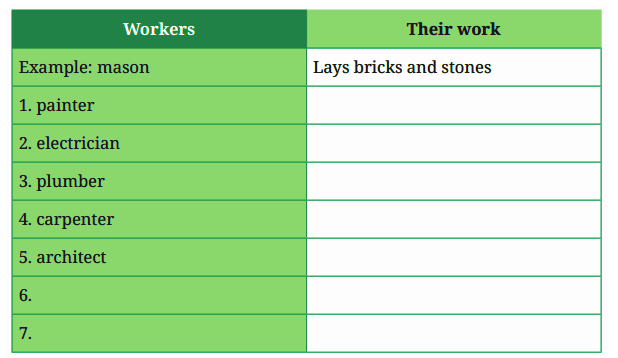
Answer:

Spices That Heal Us
Let us Do These Activities Before We Read.
1. A spice is any seed, fruit, root, bark, leaf or any other part of a plant used to give taste and colour to our food. Try to recall the names of three spices that are used for cooking in your home. Write them below and share your answers with your teacher.
Answer: Laung, Dry Chillies, Fenugreek
2. Given below are pictures of some spices. Work in pairs and write what you call them in your language. Their names in English are given in the last column. Share your answers with your teacher.
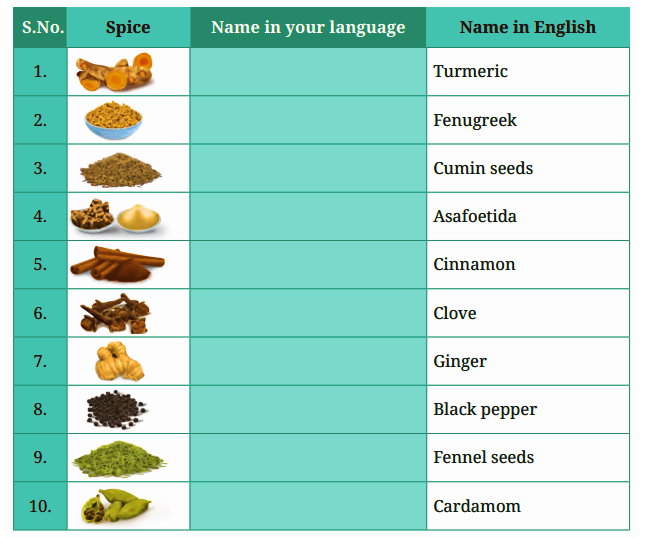
Answer:
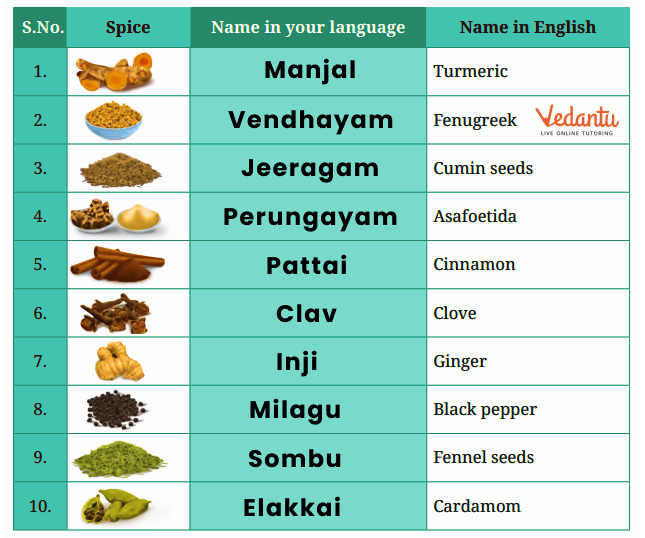
Let us Think and Reflect
1. Read the given lines and answer the following questions.
‘When I was a child, I learnt them from my grandmother. She used to find cures for most of the weather-related common illnesses in the kitchen.’
(a)Where exactly in the kitchen did her grandmother find the cures?
Ans: The grandmother found the cures in the spices commonly kept in the kitchen. She used these everyday spices like haldi (turmeric), methi (fenugreek), jeera (cumin), and others for natural remedies.
(b) Give one example of weather-related common illnesses.
Ans: One example of a weather-related common illness is a cough or cold, which can be treated with natural remedies like ginger (adrak) or neem leaves, as mentioned in the excerpt.
(c) What kind of relationship did the speaker have with her grandmother?
Ans: The speaker had a close and loving relationship with her grandmother, marked by trust and learning. The grandmother passed down valuable knowledge about natural remedies and home cures, showing a bond of care and wisdom between them.
2. Fill in the blanks to complete the sentence. Daadi soaked methi seeds overnight and drank the water in the morning to manage _____________________ and _____________________.
Ans: Sugar level and body weight
3. Circle the spice that is not useful for body pain according to Daadi’s letter. (a) Turmeric (c) Fennel seeds (b) Ginger (d) Black pepper
Ans: Fennel Seeds
4. Why did Daadi ask Vikram and Vaibhavi to share the natural cures with their friends?
Ans: Daadi asked Vikram and Vaibhavi to share the natural cures with their friends so that this traditional knowledge could be passed on to others, helping more people benefit from these simple, effective remedies. She wanted them to remember the cures and ensure the wisdom is shared within their community.
5. What was Daadi’s final advice to Vikram and Vaibhavi?
Ans: Daadi’s final advice to Vikram and Vaibhavi was to continue learning about the benefits of spices and natural remedies and to consult experienced elders before using them. She encouraged them to discover more about these cures as they grow up.
6. How do we know that natural cures are passed from one generation to another?
Ans: We know that natural cures are passed from one generation to another because Daadi mentions that she learned these remedies from her grandmother and is now sharing them with Vikram and Vaibhavi. This shows the transfer of traditional knowledge across generations.
7. Why do you think we should know about the healing properties of spices?
Ans: We should know about the healing properties of spices because they offer natural and easily accessible remedies for common illnesses, helping us maintain our health without relying solely on synthetic medicines. Understanding these properties allows us to make better use of everyday kitchen ingredients for our well-being and to pass on this valuable knowledge to future generations.
Let us Learn
1. You have read the uses of spices in the letter. Complete the following table with the help of your teacher. You may use the words from the box given below.
|

Ans:

2. Read the sentences given below.
You may share them with your friends.
You should try to remember these cures.
It can help to control cough and cold.
You must consult an elder before you use them.
I need to soak the methi seeds overnight.
I used to put heeng water on your tummy.
(a) The words given in Column A are helping verbs. Match the helping verbs in Column A with their functions in Column B.
Column A Helping Verbs | Column B Helping Verbs |
| a. Past habit |
| b. suggestion |
| c. compulsion |
| d. advice |
| e. ability |
| f. necessity |
Ans:
May - Compulsion
Should - Advice
Can - ability
Must - Necessity
Need to - Suggestion
Used to - Past Habit
(b) Complete the following dialogues with any four modals from the table given above. (Use a modal only once.)
Ajay : Anand had fever last week. He (i) _____________ take good rest.
Suman : Yes, he (ii) _____________ or he will fall ill again.
Ajay : He (iii) _____________ take grandmother’s natural cures.
Suman: Yes, we (iv) _____________ remember how effective they are
Ans:
(i) should
(ii) Must
(iii) Can
(iii) need to
Let us Listen
You will listen to the benefits of Tulsi (Holy Basil), a common herb. As you
listen, complete the factsheet given below. A transcript is given below.
Transcript:
Spices that Heal us
The wonder herb: Tulsi is a shrub in the basil family. It is said that it was first found in north central India and now grows almost everywhere in India. It is known as ‘the Queen of Herbs’ and has many medicinal uses. Studies show that it helps to decrease glucose and cholesterol levels and improve blood pressure. It is commonly used to treat breathing and digestion disorders. As it has anti-bacterial properties, it is used in herbal hand sanitisers. It is used as a base for making herbal mouth wash and toothpaste for treating bad breath, gum disease, and mouth ulcers.
Tulsi leaves can be washed and eaten raw. We can also add Tulsi leaves when we make tea. Tulsi tea helps in dealing with stress as it calms our mind. Tulsi protects us from a vast range of pollutants around us.

Ans:
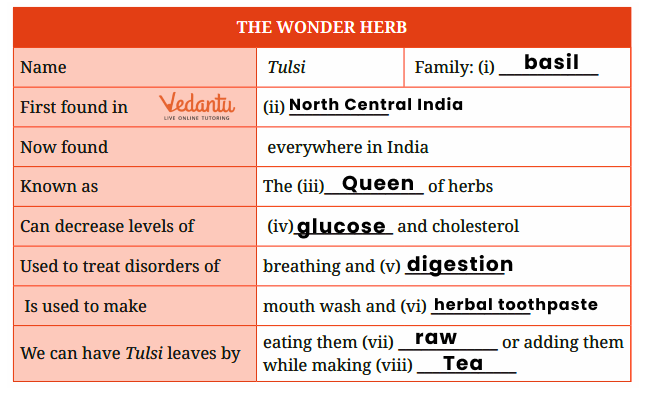
Let us Write
1. Vikram’s grandmother shared two natural cures to cure his cough in her earlier letter. It was kept outside and a few drops of rain fell on it. Some of the words got washed away by the rain. Help Vikram complete the natural cures. Use the phrases given in the box below. There are two phrases that you do not need.
Some leaves of basil The mixture You can have it For cough For high fever Grind to get Amount of honey A fresh piece of ginger Home remedy |
(a) To prepare this home remedy, you just need ginger and honey. First, take ____________________, grate it and take the juice from it. Take about two teaspoons of this juice and add about two and half teaspoons of honey to it. Mix it properly. Warm ____________________ slightly on very low heat for a minute. Then ____________________ about three to four times a day to get relief from cough. Have patience to see the effect as natural cures ____________________ with ginger and honey might take some time to show results.
Answer:
(a) To prepare this home remedy, you just need ginger and honey. First, take some leaves of basil, grate it and take the juice from it. Take about two teaspoons of this juice and add about two and half teaspoons of honey to it. Mix it properly. Warm the mixture slightly on very low heat for a minute. Then you can have it about three to four times a day to get relief from cough. Have patience to see the effect as natural cures for cough with ginger and honey might take some time to show results.
(b) To prepare the second ____________________ for cough, take about 10 grams of each long pepper, dried ginger and basil leaves. Add four to six small cardamoms and ____________________ a fine powder. If you take this powder with an equal ____________________, it will give you relief from cough.
Answer: (b) To prepare the second home remedy for cough, take about 10 grams of each long pepper, dried ginger and basil leaves. Add four to six small cardamoms and grind them to get a fine powder. If you take this powder with an equal amount of honey , it will give you relief from cough.
2. Now, write a short paragraph on Tulsi based on the completed factsheet in ‘Let us listen’.
Answer: Tulsi, also known as the "Queen of Herbs," is a powerful medicinal plant found across India. It is renowned for its numerous health benefits, such as reducing glucose and cholesterol levels, improving blood pressure, and treating respiratory and digestive disorders. With its strong anti-bacterial properties, Tulsi is used in herbal hand sanitizers, mouthwash, and toothpaste to combat bad breath and gum disease. Tulsi leaves can be consumed raw, added to tea, or used in various home remedies to alleviate stress and protect against pollutants.
Let us Explore
1. Now that you have read about many spices, can you guess the spices based on the riddles given below?

Answer: Heeng, Ginger
2. Fill in the blanks to complete the riddle below. Write another riddle of your own and ask your family members to guess the spice.

Answer:

b) I’m golden and bright, used in many a dish,
I heal wounds and cuts, that’s my magic twist.
In curries, I add color, in milk, I fight cold,
What am I, in the spice world, so bold?
Ans: I am Turmeric!
Benefits of NCERT Solutions for Class 6 English Chapter 3
NCERT Solutions for Class 6 English Chapter 3 from the Poorvi textbook provides detailed explanations of the chapter, helping students grasp the key concepts and themes clearly.
By reading and understanding the solutions, students can enhance their vocabulary and language skills, which are crucial for mastering English.
These solutions serve as an excellent revision tool, allowing students to quickly review important points before exams.
With accurate answers and explanations, students can gain confidence in their ability to tackle exam questions related to the chapter.
NCERT Solutions for Class 6 English Chapter 3 provides reliable support for completing homework assignments, ensuring that students can submit accurate and well-structured answers.
Important Study Material for English Chapter 3 Class 6-
S.No. | Important Study Material Links for Chapter 3 |
1. | Class 6 English Chapter 3 Important Questions |
2. | Class 6 English Chapter 3 Revision Notes |
Conclusion
NCERT Solutions for Class 6 English Chapter 3 provides students with a valuable resource for understanding the chapter's content thoroughly. These solutions not only help in enhancing language skills but also offer support in exam preparation and homework completion. By using these solutions, students can build a strong foundation in English, ensuring academic success and improved confidence in their abilities.
NCERT Class 6 English (Poorvi) Solutions Chapter-wise Links - Download the FREE PDF
S.No. | Chapter Name | Chapter-wise Topics |
1 |
| |
2 |
| |
3 |
| |
4 |
| |
Related Important Links for English (Poorvi) Class 6
Along with this, students can also download additional study materials provided by Vedantu for English Class 6 –
S.No. | Important Links for Class 6 English |
1. | |
2. | |
3. | |
4. |
FAQs on NCERT Solutions for Class 6 English Poorvi Chapter 3 Nurturing Nature 2025-26
1. What is the central theme of Class 6 English Chapter 3, 'Nurturing Nature'?
The chapter 'Nurturing Nature' focuses on the importance of caring for our environment. It teaches students about their responsibility to protect plants, animals, and natural resources, fostering respect and a sense of connection with the world around them.
2. How can students contribute to nurturing nature?
Students can nurture nature through simple actions like planting saplings, saving water and electricity, avoiding plastic use, and keeping their surroundings clean. Feeding birds and animals also shows care for the ecosystem and helps maintain its balance.
3. Where can I find correct Nurturing Nature Class 6 questions and answers?
NCERT Solutions for Class 6 English Chapter 3 are available on Vedantu. These expert-verified answers cover all in-text and exercise questions, helping you understand the chapter's core concepts clearly and prepare for your exams effectively.
4. What moral lesson does the chapter 'Nurturing Nature' teach?
The primary moral lesson is that humans share a vital responsibility to protect and preserve nature. It highlights that our well-being is interconnected with the health of our environment and all living creatures within it.
5. How do NCERT Solutions for Class 6 English Chapter 3 help with exam preparation?
The solutions provide clear, step-by-step answers that follow the CBSE marking scheme. Practising with them helps you understand the correct way to frame answers, manage time better, and revise the entire chapter effectively before exams.
6. Can I download a PDF for the Class 6 English Chapter 3 solutions?
Yes, you can download a Free PDF of the NCERT Solutions for 'Nurturing Nature' from Vedantu's website. This allows for easy offline access, letting you study and revise the questions and answers anytime, anywhere, even without an internet connection.
7. What is included in the NCERT Solutions for this chapter?
The solutions provide answers for all textbook exercises, including comprehension questions, vocabulary, and grammar sections. Each answer is crafted by subject matter experts to be accurate, easy to understand, and aligned with the NCERT curriculum.
8. How does the chapter 'Nurturing Nature' explain the human-nature relationship?
The chapter explains that humans are not separate from but a part of nature. It illustrates that our actions, positive or negative, directly impact the environment, emphasizing the need for a harmonious and respectful coexistence.
9. Why is it important to solve every Class 6 English Chapter 3 question?
Solving every question ensures a thorough understanding of the chapter’s themes, vocabulary, and literary elements. It strengthens comprehension skills and prepares you to tackle similar questions confidently in your exams.
10. Are these solutions for 'Nurturing Nature' based on the updated NCERT syllabus?
Yes, the NCERT Solutions are fully updated to align with the latest 2024-25 NCERT syllabus and CBSE guidelines. They accurately reflect the current curriculum to ensure students receive relevant and correct guidance for their studies.
























